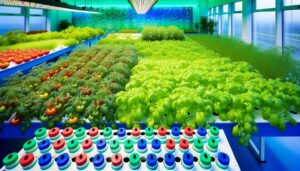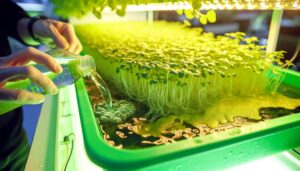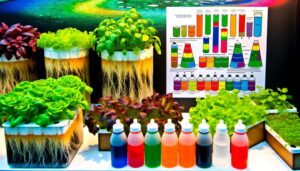Mastering the Advanced Nutrients Hydroponic Feeding Chart Explored in 10 Steps
The Advanced Nutrients Hydroponic Feeding Chart precisely schedules nutrient delivery to maximize plant growth at each developmental stage. By following this data-driven approach, hydroponic growers can guarantee ideal nutrient uptake, avoiding deficiencies and toxicities.
Key nutrients, including nitrogen, phosphorus, and potassium, are tailored for each growth phase, from seedling to bloom. Research shows that using these feeding charts can lead to 25-30% faster growth rates compared to soil-based methods.
Monitoring pH and electrical conductivity (EC) levels is essential for success. For a deeper understanding of how to enhance your hydroponic system, explore further details and guidelines.
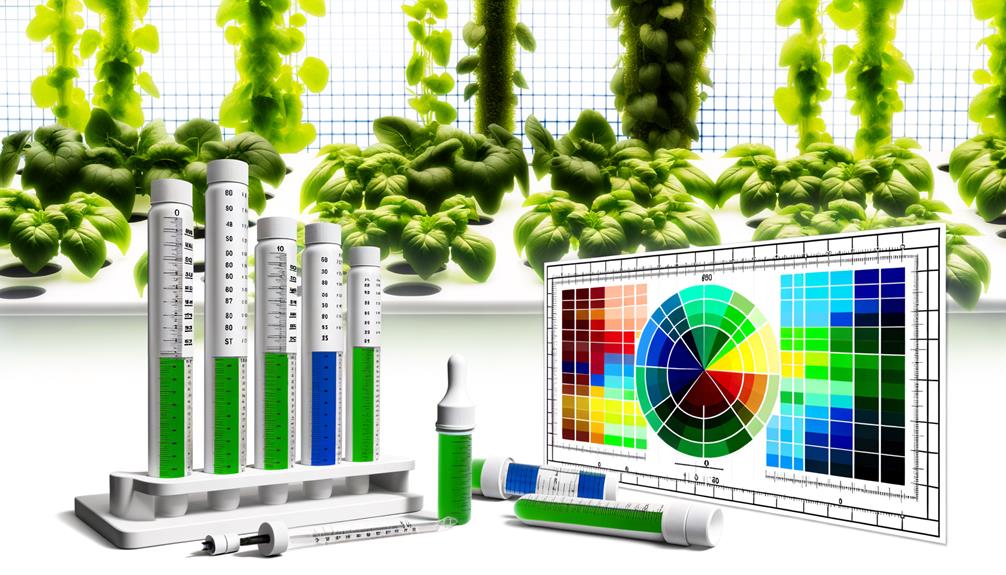
Key Takeaways
- Advanced Nutrients feeding chart optimizes nutrient delivery schedules for different growth stages, enhancing plant health and yield.
- Seedlings require balanced nutrients with lower concentrations of N-P-K and a pH range of 5.5 to 6.0.
- Vegetative stage needs higher nitrogen, with recommended N-P-K ratio 3-1-2, and EC levels of 1.0 to 1.4 mS/cm.
- Bloom stage focuses on higher phosphorus, with an N-P-K ratio of 1-3-2, and pH levels between 5.8 and 6.3.
Advanced Nutrients Hydroponic Feeding Chart for Optimal Growth
| No. | Growth Stage | Product Name | Amount (per gallon) | Frequency | Notes |
|---|---|---|---|---|---|
| 1 | Seedling (Week 1-2) | Voodoo Juice | 2 mL | Once a week | Enhances root development |
| 2 | Seedling (Week 1-2) | B-52 | 2 mL | Once a week | Boosts energy and resilience |
| 3 | Vegetative (Week 3-4) | Sensi Grow A & B | 4 mL each | Every feeding | Balanced nutrient for growth |
| 4 | Vegetative (Week 3-4) | Voodoo Juice | 2 mL | Once a week | Promotes root mass growth |
| 5 | Vegetative (Week 3-4) | B-52 | 2 mL | Every feeding | Stress relief and vigor boost |
| 6 | Bloom (Week 5-6) | Sensi Bloom A & B | 4 mL each | Every feeding | Nutrient boost for flowering |
| 7 | Bloom (Week 5-6) | Big Bud | 2 mL | Once a week | Encourages larger blooms |
| 8 | Bloom (Week 7-8) | Overdrive | 2 mL | Once a week | Maximizes bloom size and density |
| 9 | Bloom (Week 7-8) | Bud Candy | 2 mL | Once a week | Sweetens buds, enhances flavor |
| 10 | Final Flush (Week 9) | Flawless Finish | 2 mL | Last week of flush | Cleanses plant of excess salts |
Understanding Hydroponic Basics
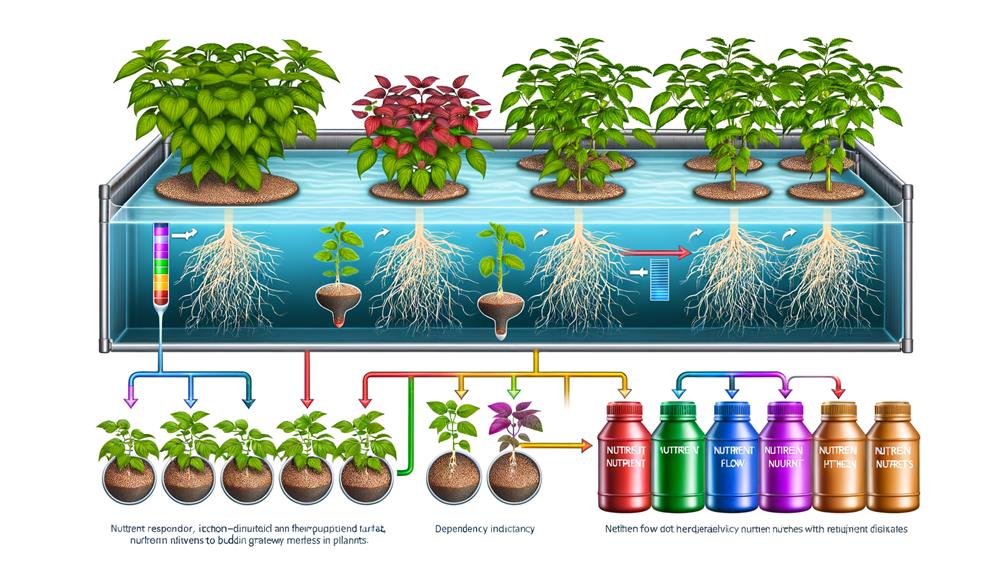
Understanding the fundamental principles of hydroponics is vital for maximizing plant growth and achieving successful crop yields. Hydroponics involves the cultivation of plants in a nutrient-rich water solution, bypassing traditional soil mediums.
Key components include nutrient solutions, pH levels, and water quality, all of which must be meticulously managed to guarantee ideal plant health. Research indicates that precise control of these variables can lead to growth rates 25-30% faster than soil-based methods (Jones, 2014).
Nutrient uptake efficiency is enhanced in hydroponics, as roots directly access essential minerals. Additionally, environmental control systems, such as light, temperature, and humidity, play significant roles.
Mastery of these fundamentals allows for predictable, high-quality yields, making hydroponics a viable option for modern agriculture.
Importance of Feeding Charts
Feeding charts are essential tools in hydroponics, providing precise guidelines for nutrient delivery schedules that maximize plant growth and health. These charts help growers maintain the right balance of macronutrients and micronutrients, ensuring optimal plant development at each stage. The Remo Nutrients feeding chart is a popular choice among hydroponic enthusiasts, offering a clear schedule for dosing essential nutrients. By following a well-structured feeding plan, growers can prevent nutrient deficiencies and achieve consistent, high-quality yields.
These charts are based on extensive research and empirical data, allowing growers to administer the right nutrient concentrations at various plant growth stages.
By adhering to a feeding chart, cultivators can avoid nutrient deficiencies and toxicities, ensuring plants receive a balanced supply of macro and micronutrients.
Studies indicate that structured nutrient regimes can enhance root development, chlorophyll production, and overall biomass yield.
Additionally, feeding charts facilitate consistency and reproducibility in hydroponic systems, which are critical for experimental validation and commercial scalability.
Essentially, feeding charts are indispensable for achieving peak hydroponic cultivation outcomes.
Key Nutrients for Hydroponics
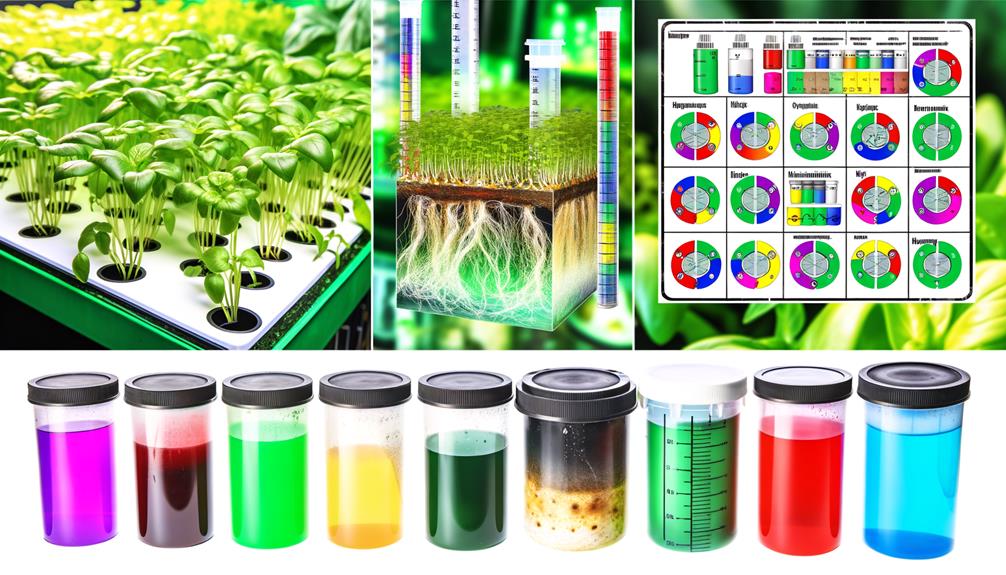
In hydroponics, key nutrients such as nitrogen, phosphorus, potassium, calcium, magnesium, and sulfur are critical for perfect plant growth and development.
Nitrogen (N) is essential for chlorophyll production and amino acid synthesis, directly influencing photosynthesis and growth rates.
Phosphorus (P) plays a pivotal role in energy transfer through ATP, crucial for root development and flowering.
Potassium (K) aids in enzyme activation and osmotic regulation, enhancing overall plant health and disease resistance.
Calcium (Ca) is fundamental for cell wall integrity and membrane function, while magnesium (Mg) is a central component of chlorophyll and enzyme co-factors.
Sulfur (S) is necessary for synthesizing amino acids and vitamins.
These nutrients, meticulously balanced, guarantee peak plant productivity in hydroponic systems.
Growth Stages Explained
Understanding the nutrient requirements at each growth stage is essential for optimizing hydroponic crop yields.
During the seedling phase, plants necessitate a balanced supply of macro and micronutrients to establish strong root systems and early vegetative growth.
As the plants shift to the flowering stage, adjusting the feeding regimen to increase phosphorus and potassium concentrations can greatly enhance bloom density and quality.
Seedling Phase Nutrient Needs
During the seedling phase, precise nutrient management is critical for establishing a robust root system and promoting ideal early growth.
Research indicates that seedlings require lower concentrations of nutrients compared to later growth stages. Ideal electrical conductivity (EC) levels should range from 0.5 to 0.8 mS/cm to prevent nutrient burn.
Nitrogen is essential for early vegetative development, while phosphorus supports root formation. Micronutrients such as calcium and magnesium are crucial for cellular structure and function.
Data-driven practices suggest maintaining a pH range of 5.5 to 6.0 to maximize nutrient uptake.
Monitoring and adjusting these parameters based on real-time data guarantees seedlings develop healthily, setting the foundation for subsequent growth stages.
Flowering Stage Feeding Tips
As plants progress from the seedling phase to the flowering stage, nutrient requirements shift markedly to support bud development and maximize yield potential. During this critical phase, a precise nutrient regimen is crucial.
Research indicates the following key adjustments:
- Increase Phosphorus (P) and Potassium (K): These elements are essential for bloom formation and overall plant health.
- Reduce Nitrogen (N): Excessive nitrogen can inhibit flowering and lead to undesirable vegetative growth.
- Monitor pH Levels: Ideal pH (5.5-6.5) guarantees nutrient availability and absorption efficiency.
- Implement Bloom-specific Supplements: Products rich in amino acids, humic acids, and specific hormones can enhance bud density and potency.
These adjustments, grounded in scientific research, are designed to enhance flowering and secure high-quality yields.
Seedling Stage Feeding
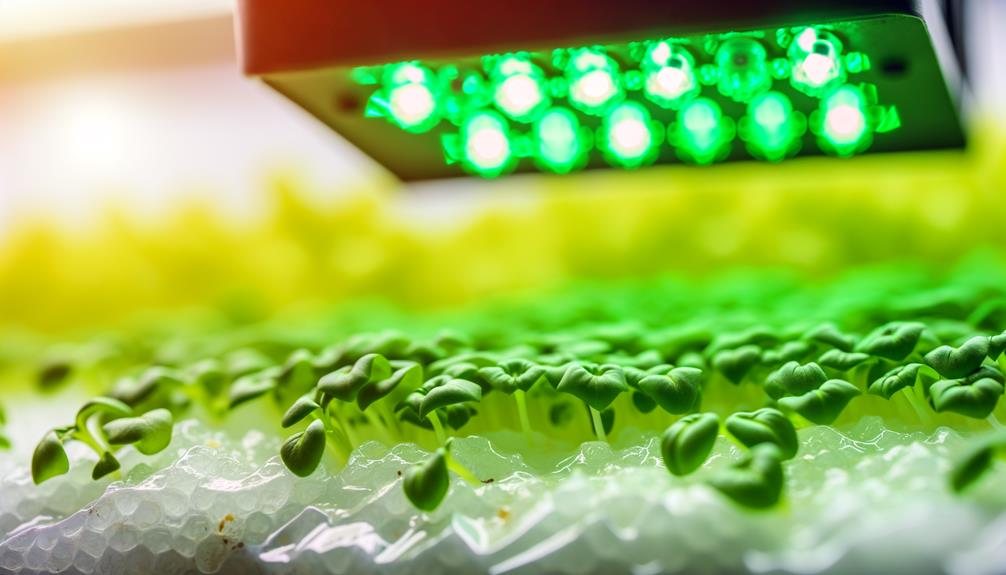
Effective seedling stage feeding necessitates a balanced nutrient solution formulated to support early root development and initial leaf growth.
Research indicates that an ideal nutrient solution for seedlings contains lower concentrations of nitrogen (50-100 ppm), phosphorus (30-50 ppm), and potassium (70-100 ppm).
Additionally, micronutrients such as calcium, magnesium, and iron are vital during this stage to prevent deficiencies that can impede growth.
Maintaining a pH between 5.5 and 6.0 is critical for peak nutrient uptake.
Data-driven approaches recommend using a diluted nutrient solution at 25% of the strength used for mature plants.
Regular monitoring of electrical conductivity (EC) at 0.6-0.8 mS/cm guarantees the solution remains within the peak range for seedling health and development.
Vegetative Stage Feeding
Shifting to the vegetative stage, plants require an increased concentration of macronutrients, particularly nitrogen, to support robust stem and leaf development.
Research indicates that optimizing nutrient delivery during this phase can improve vegetative growth and overall plant health.
Key nutrients and their recommended concentrations include:
- Nitrogen (N): Essential for chlorophyll production and vegetative growth. Recommended concentration: 150-200 ppm.
- Phosphorus (P): Facilitates energy transfer and root development. Recommended concentration: 50-70 ppm.
- Potassium (K): Promotes protein synthesis and enzyme activation. Recommended concentration: 150-200 ppm.
- Calcium (Ca) and Magnesium (Mg): Vital for cell wall stability and chlorophyll production. Recommended concentrations: 100-150 ppm (Ca), 50-70 ppm (Mg).
Implementing these nutrient guidelines can greatly enhance vegetative growth and prepare plants for subsequent stages.
Bloom Stage Feeding
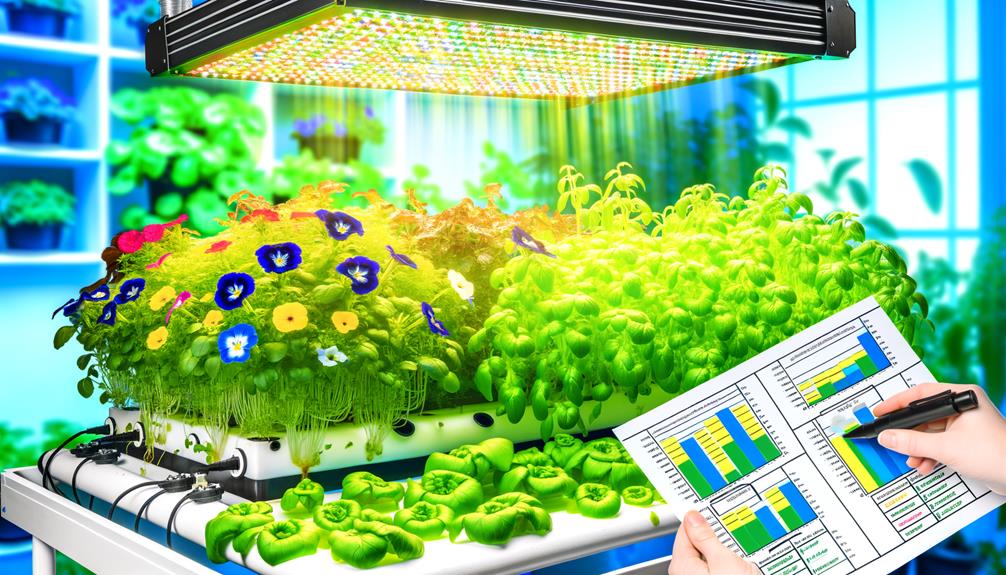
During the bloom stage, plants demand a carefully balanced nutrient regimen that prioritizes phosphorus and potassium to support flowering and fruit development.
Research indicates that phosphorus is critical for energy transfer and genetic material synthesis, while potassium enhances water uptake, enzyme activation, and stress resistance.
Empirical data suggest ideal phosphorus concentrations between 50-80 ppm and potassium levels from 150-200 ppm.
Additionally, micronutrients like magnesium and sulfur are essential for chlorophyll production and protein synthesis, respectively.
Maintaining precise pH levels between 5.8 and 6.3 guarantees maximal nutrient absorption.
Regular monitoring of electrical conductivity (EC) and total dissolved solids (TDS) is imperative to avoid nutrient imbalances, thereby enhancing plant health and yield.
Adjusting Nutrient Ratios
To enhance plant growth and maximize yield, adjusting nutrient ratios based on specific growth stages and plant requirements is vital. Research indicates that different growth phases necessitate unique nutrient formulations.
- Vegetative Stage: Emphasize higher nitrogen (N) levels to promote robust leafy growth. An N-P-K ratio of approximately 3-1-2 is recommended.
- Transition Stage: Gradually reduce nitrogen while increasing phosphorus (P) and potassium (K) to prepare plants for flowering. A balanced ratio like 2-1-2 can be effective.
- Bloom Stage: Focus on higher phosphorus levels, important for flower development. An N-P-K ratio of 1-3-2 is suitable.
- Late Bloom/Ripening Stage: Further reduce nitrogen, maintaining elevated phosphorus and potassium to enhance fruiting. An N-P-K ratio of 0-3-3 supports ideal ripening.
Accurate adjustments guarantee nutrient efficiency and peak plant performance.
Monitoring Plant Health

Monitoring plant health in a hydroponic system necessitates the systematic evaluation of leaf color, root system integrity, and growth rate.
Changes in leaf pigmentation can signal nutrient deficiencies or imbalances, while root system examination provides insights into overall plant vigor and potential pathogen presence.
Growth rate analysis, supported by quantitative measurements, allows for the timely adjustment of nutrient solutions to optimize plant development.
Leaf Color Indicators
Leaf color indicators serve as an essential diagnostic tool for evaluating the nutritional and health status of plants in hydroponic systems. Their significance lies in their ability to provide immediate, visual feedback on plant well-being.
Scientific studies have demonstrated the correlation between leaf color and specific nutrient deficiencies or toxicities. To effectively monitor and interpret these indicators, consider the following:
- Yellowing Leaves: Often indicative of nitrogen deficiency, leading to chlorosis.
- Purpling Leaves: Can signal phosphorus deficiency, particularly in cooler temperatures.
- Brown Edges: Typically associated with potassium deficiency, causing marginal necrosis.
- Interveinal Chlorosis: Suggests magnesium deficiency, manifesting as yellowing between veins.
These visual cues allow growers to make precise adjustments to nutrient solutions, ensuring ideal plant health and productivity.
Root System Examination
Examining the root system in hydroponic plants provides crucial insights into overall plant health and nutrient uptake efficiency.
Healthy roots should appear white or light tan, indicating proper oxygenation and nutrient absorption. Conversely, brown or black roots may signal hypoxic conditions or pathogenic infections such as Pythium.
Regular root inspections, preferably bi-weekly, can reveal early signs of nutrient imbalances or system inefficiencies. Quantitative metrics such as root length, biomass, and root-to-shoot ratio can further elucidate plant liveliness.
Additionally, root health directly correlates with the effectiveness of the nutrient solution, as documented by studies showing enhanced growth rates in hydroponic systems with optimized root environments.
Structured, data-driven root examinations are essential for maintaining robust hydroponic systems.
Growth Rate Analysis
Accurate growth rate analysis serves as a pivotal metric for evaluating the overall health and vigor of hydroponic plants. This assessment is integral to optimizing nutrient delivery, light exposure, and environmental conditions. By systematically monitoring growth rates, cultivators can detect potential issues early and adjust their strategies accordingly.
Key parameters to track include:
- Daily Height Increase: Measure height consistently to detect deviations from expected growth patterns.
- Leaf Area Expansion: Monitor leaf surface area, which directly correlates with photosynthetic efficiency.
- Root Mass Development: Evaluate root growth to guarantee nutrient uptake efficacy.
- Biomass Accumulation: Weigh plants periodically to assess overall biomass gain.
Analyzing these metrics with scientific precision facilitates data-driven decisions, enhancing plant health and maximizing yield.
Common Mistakes to Avoid
One of the most common mistakes in hydroponic feeding is the improper calibration of nutrient solutions, which can lead to nutrient imbalances and hinder plant growth.
Research indicates that even slight deviations in pH and electrical conductivity (EC) levels can considerably impact nutrient uptake efficiency. According to a study published in the Journal of Plant Nutrition, maintaining pH levels between 5.5 and 6.5 is vital for ideal nutrient absorption.
Additionally, failure to regularly monitor and adjust these parameters can result in nutrient lockout or toxicity. Overfeeding and underfeeding are also prevalent issues; data suggests that precise adherence to feeding charts can mitigate these risks.
Accurate calibration and consistent monitoring are fundamental for achieving a balanced nutrient environment.
Tips for Maximizing Yield
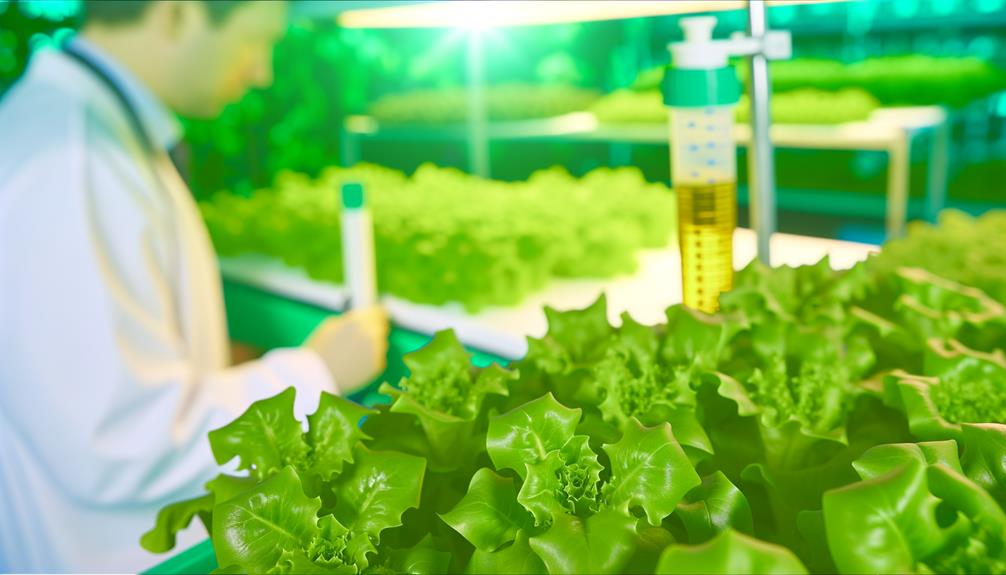
Maximizing yield in hydroponic systems requires careful attention to several critical factors.
Research indicates that ideal light exposure, precise nutrient timing strategies, and strategic pruning can greatly enhance plant growth and productivity.
Optimal Light Exposure
Consistently providing hydroponic plants with the ideal spectrum and intensity of light is essential for maximizing yield and promoting robust growth. Research indicates that fine-tuning light exposure can greatly impact plant health and productivity.
Here are four data-driven strategies to achieve optimal light exposure:
- Light Spectrum: Utilize full-spectrum LED lights to mimic natural sunlight, promoting photosynthesis and balanced growth.
- Intensity: Maintain a Photosynthetic Photon Flux Density (PPFD) of 400-600 µmol/m²/s for vegetative stages and 600-1000 µmol/m²/s for flowering stages.
- Duration: Implement a photoperiod of 18 hours of light and 6 hours of darkness during vegetative growth, shifting to 12 hours each during flowering.
- Distance: Position lights 12-24 inches above the canopy to prevent light burn and guarantee even distribution.
These practices are grounded in scientific research, promoting optimal plant development.
Nutrient Timing Strategies
How can precise nutrient timing greatly enhance the yield and health of hydroponic plants?
Research indicates that delivering nutrients at specific growth stages can optimize plant development. During the vegetative phase, higher nitrogen levels support robust leaf and stem growth. Conversely, the flowering phase demands increased phosphorus and potassium for bud and fruit development.
Studies show that hydroponic systems with carefully timed nutrient delivery can see a 20-30% yield increase compared to untimed feedings. Additionally, monitoring electrical conductivity (EC) and pH levels guarantees nutrient uptake efficiency.
Data-driven strategies, such as using automated dosing systems, can further refine nutrient timing, leading to healthier plants and maximized yields. Precision in nutrient scheduling is therefore a pivotal factor in hydroponic success.
Pruning for Growth
In addition to precise nutrient timing, strategic pruning techniques are essential for optimizing plant growth and maximizing yield in hydroponic systems. Research indicates that effective pruning can enhance light penetration and air circulation, contributing to healthier plants.
Here are four key pruning techniques:
- Topping: Cutting the main stem to encourage lateral growth, effectively increasing the number of flowering sites.
- Lollipopping: Removing lower branches and leaves to focus the plant’s energy on top growth, optimizing nutrient use.
- Defoliation: Selectively removing leaves to improve light distribution and air flow, thereby reducing the risk of mold.
- Pinching: Gently pinching new growth tips to promote bushier plants, which can result in higher yields.
These evidence-based methods are integral to achieving maximal hydroponic yields.
Conclusion
In summary, adhering to a hydroponic feeding chart is vital for optimizing plant growth and health.
Research indicates that plants grown hydroponically can yield up to 25% more produce compared to traditional soil methods, underscoring the importance of precise nutrient management.
Understanding the specific nutrient needs at various growth stages, from seedling to harvest, and adjusting nutrient ratios accordingly, can greatly enhance the efficiency and productivity of hydroponic systems.
Proper monitoring and avoidance of common mistakes are essential for maximizing yield.



